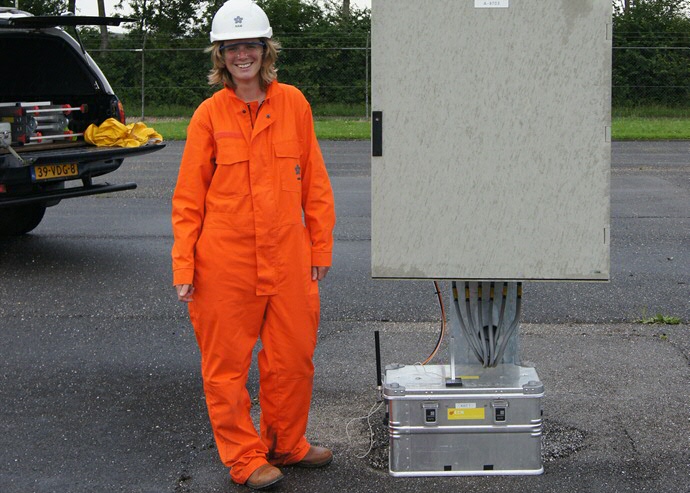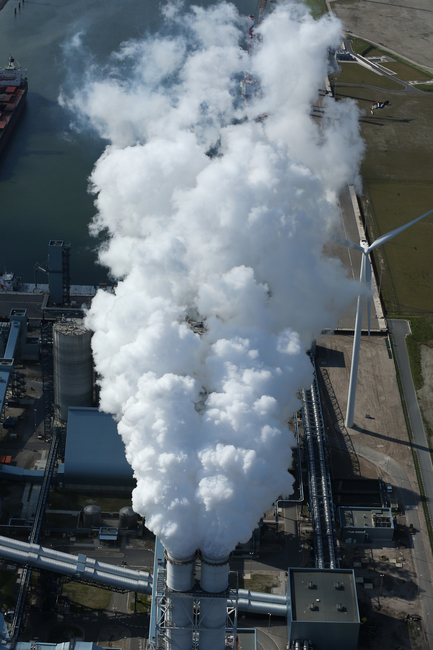Nieuwe techniek kan lekkage ondergrondse CO 2 -opslag meten

RUG-promovenda Charlotte van Leeuwen heeft een techniek ontwikkeld waarmee lekkage van kooldioxide (CO2) uit een ondergrondse opslag is te meten. Dit is belangrijk voor het controleren of dit soort opslag het broeikasgas werkelijk uit de atmosfeer houdt. Van Leeuwen promoveert op 27 november 2015 aan de Rijksuniversiteit Groningen.
Charlotte van Leeuwen begon haar onderzoek in 2010, toen de regering de mogelijkheid onderzocht om het broeikasgas kooldioxide (CO2) op te slaan in lege gasvelden. Dit veroorzaakte nogal wat onrust bij de mensen die rond mogelijke proeflocaties woonden en het plan om ondergronds op te slaan onder land werd al snel van de agenda gehaald. Maar het onderzoek van Van Leeuwen ging door.

Proeflocaties
‘Er zijn in andere landen verschillende proeflocaties, onder meer in de VS. Dan is het belangrijk te weten of het broeikasgas ook werkelijk onder de grond blijft,’ zegt Van Leeuwen. Injectie van CO2 is een kostbare zaak, en wanneer een belangrijk deel van het gas op korte termijn toch weer in de atmosfeer terechtkomt, kan het zeker niet uit.
Meer detectoren
Het is niet eenvoudig om een lek van CO2 te detecteren in de atmosfeer, omdat het ontsnapte gas snel mengt met de omgeving en de CO2-concentratie in de atmosfeer van nature al vrij sterk varieert. Aan één CO2-sensor heb je dus niets. Maar wanneer er een aantal sensoren staat en je ziet dat er één een afwijkende meting geeft, kan dat wijzen op een lek. Om dit te testen zette van Leeuwen vijf relatief eenvoudige detectoren rond een kunstmatig CO2-lek in een raster van 70 bij 70 meter. De methode werkte, maar de detectoren bleken onder meer verschillend te reageren op temperatuur, zodat verschillende correcties nodig waren. Een nadeel van deze methode is dat het geen onderscheid kan maken tussen een CO2-lek en een andere bron van CO2, zoals de verbranding van fossiele brandstoffen.
Kooldioxide en zuurstof
Een techniek waarbij niet alleen de atmosferische CO2-concentratie maar ook de concentratie zuurstof (O2)-wordt gemeten, kan dit onderscheid wel maken. ‘In natuurlijke processen is de variatie in de CO2- en O2-concentratie gelijk van grootte, maar tegengesteld’, legt Van Leeuwen uit. ‘Overdag nemen planten bijvoorbeeld CO2 op en staan ze O2 af. Bij verbranding van bijvoorbeeld hout of steenkool komt CO2 vrij, en wordt O2 verbruikt.’ Een lekkage van CO2 uit een opslag geeft echter een stijging van de kooldioxideconcentratie, zonder daling in de zuurstofconcentratie.
Orde van grootte
Deze techniek is niet eenvoudig, omdat het een zeer nauwkeurige meting van de O2-concentratie vraagt. De variaties in de atmosfeer van beide gassen zijn vergelijkbaar, maar de achtergrondconcentratie van zuurstof is ordes van grootte hoger dan die van koolstofdioxide (21% of 210.000 ppm (parts per million) zuurstof tegen 400-500 ppm koolzuurgas). ‘Een verschil van 10 ppm in de CO2-concentratie is relatief dus veel meer dan eenzelfde verschil in de O2-concentratie.’
Centrum voor Isotopenonderzoek
Het Centrum voor Isotopenonderzoek (CIO) van de RUG is een van de weinig instituten in de wereld die zo’n nauwkeurige meting in huis heeft. ‘Maar dat gebeurt met apparatuur die vast in een lab staat. Mijn opdracht was om een installatie te maken die relatief eenvoudig te verplaatsen is. Dat lukte. Maar doordat de metingen zo ingewikkeld zijn en er veel apparatuur en onder andere ook meerdere gascilinders nodig zijn, blijft dit een vrij lastige operatie.’
Detectielimiet
Door gelijktijdige meting van CO2 en O2 kon Van Leeuwen een toename van CO2 van 6 ppm bovenop de natuurlijke variatie meten. Wanneer de precisie van de zuurstofmetingen nog verder verbeterd wordt, zou de detectielimiet naar 3 ppm gebracht kunnen worden. Dit komt neer op het detecteren van een lek van 1000 ton CO2 per jaar (32 gram per seconde) op een afstand van 500 meter.
Ook als er geen ondergrondse opslag onder land komt, is haar installatie bruikbaar voor onderzoek. Omdat het systeem mobiel is kan het eenvoudig worden ingezet bij meetcampagnes waar tijdelijk zuurstofmetingen nodig zijn.
Promotie
Charlotte van Leeuwen promoveert op 27 november 2015 aan de RUG op onderzoek dat zij uitvoerde bij het Centrum voor Isotopen Onderzoek, onderdeel van het Energy and Sustainability Research Institute Groningen (ESRIG). Het werd gefincierd door CATO2. De titel van haar proefschrift is: Highly precise atmospheric oxygen measurements as a tool to detect leaks of carbon dioxide from Carbon Capture and Storage sites . Haar promotor is prof.dr. H.A.J. (Harro) Meijer.

Meer nieuws
-
06 januari 2026
AI-phasie: kunstmatige intelligentie helpt bij taalgebrek
